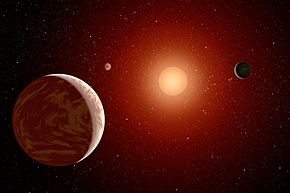Wolf 1061c
 Artist's impression of the planetary system around Wolf 1061. | |
| Discovery[1] | |
|---|---|
| Discovered by | University of New South Wales,Australia |
| Discovery site | European Southern Observatory |
| Discovery date | 17 December 2015 |
| Radial velocity | |
| Orbital characteristics[2] | |
| 0.0890+0.0029 −0.0031AU | |
| Eccentricity | 0.11+0.10 −0.07 |
| 17.8719±0.0059d | |
| Semi-amplitude | 1.92±0.19m/s |
| Star | Wolf 1061 |
| Physical characteristics | |
| 1.66R🜨[3] | |
| Mass | ≥3.41+0.43 −0.41M🜨[2] |
| Temperature | 223 K (−50 °C; −58 °F)[4] |
Wolf 1061 cis anexoplanetorbiting within thehabitable zoneof thered dwarfstarWolf 1061in theconstellationOphiuchus,about 14.1light-yearsfromEarth.At the time of discovery, it was the closest known potentially habitable exoplanet to Earth, though several closer ones have since been found.[5][6]It is the second planet in order from its host star in atriple planetary system,and has anorbital periodof 17.9 days. Wolf 1061 c is classified as asuper-Earthexoplanetas its mass is between that of Earth and theice giants.
Characteristics
[edit]Mass, radius and temperature
[edit]Wolf 1061 c is thought to be asuper-Earthexoplanetas itsminimum massis about 3.4 times that of Earth. Its radius is unknown, but predicted to be about 1.6 times that of Earth.[1]The planet has anequilibrium temperatureof 223 K (−50 °C; −58 °F), slightly higher than that ofMars.[4]
In astronomical terms, the Wolf 1061 system is relatively close to Earth, at only 14.1 light years away.[5][6]
Discovery
[edit]The discovery was announced on 17 December 2015, following a study that used 10 years of archival spectra of the star Wolf 1061 using theHARPSspectrographattached to theESO 3.6 m Telescopeat theEuropean Southern ObservatoryatLa Silla,Chile.[5][1]
Host star
[edit]The planet orbits aM-typestarnamedWolf 1061,which is orbited by a total of three planets. The star has a mass of 0.25M☉and a radius of 0.26R☉.It has a temperature of 3380K.The age is poorly constrained/unknown, but estimates would place it around a few billion years. In comparison, theSunis 4.6 billion years old[7]and has a surface temperature of 5778 K.[8]
The star'sapparent magnitude,or how bright it appears from Earth's perspective, is 10.1m.Therefore, it is too dim to be seen with the naked eye.
Orbit
[edit]Wolf 1061 c orbits its host star with less than 1% of the Sun's luminosity every 17.9 days at a distance of 0.08astronomical units(AU) (compared toMercurywhich orbits at a distance of 0.38 AU).[1]
Habitability
[edit]The planet's orbital distance of 0.084AU(assuming mildeccentricity) lies at the inner edge of its star'shabitable zone,which extends from approximately 0.073 to 0.190 AU (for comparison, the habitable zone of theSunis approximated at 0.5 to 3.0 AU for its different energy emission). Its host star is ared dwarf,with about a quarter as much mass as the Sun. As a result, stars like Wolf 1061 have the ability to burn up to 400–500 billion years, 40–50 times longer than the Sun will.[9]
Because it is so close to the star, it is likely to betidally locked,meaning one side permanently faces the star and the other side permanently faces away. Although this scenario could result in extreme temperature differences on the planet,[10]theterminator linethat separates the illuminated side and the dark side could potentially behabitable.Additionally, a much larger portion of the planet could also be habitable if it has a thick enough atmosphere to facilitate heat transfer away from the side facing the star.[6]
A 2017 study concluded that it is unlikely that the planets within the system, including Wolf 1061c, have any surface water, hypothesizing that it is arunaway greenhousecandidate as they lie within theVenus zoneof Wolf 1061.[11]
See also
[edit]References
[edit]- ^abcdWright, D. J; Wittenmyer, R. A; Tinney, C. G; Bentley, J. S; Zhao, Jinglin (2016)."Three Planets Orbiting Wolf 1061".The Astrophysical Journal Letters.817(2): L20.arXiv:1512.05154.Bibcode:2016ApJ...817L..20W.doi:10.3847/2041-8205/817/2/L20.S2CID52320394.
- ^abAstudillo-Defru, Nicola; Forveille, Thierry; Bonfils, Xavier; Ségransan, Damien; Bouchy, François; Delfosse, Xavier; et al. (2017)."The HARPS search for southern extra-solar planets. XLI. A dozen planets around the M dwarfs GJ 3138, GJ 3323, GJ 273, GJ 628, and GJ 3293".Astronomy and Astrophysics.602.A88.arXiv:1703.05386.Bibcode:2017A&A...602A..88A.doi:10.1051/0004-6361/201630153.S2CID119418595.
- ^"Exoplanet-catalog".Exoplanet Exploration: Planets Beyond our Solar System.Retrieved30 January2024.
- ^ab"The Habitable Exoplanets Catalog - Planetary Habitability Laboratory @ UPR Arecibo".NASAExoplanet Archive.Retrieved3 February2024.
- ^abc"Astronomers discover closest potentially habitable planet: Wolf 1061 c".ScienceAlert.17 December 2015.Retrieved17 December2015.
- ^abcStrom, Marcus (17 December 2015)."Wolf 1061 c: closest planet found orbiting in a star's habitable zone 14 light years from Earth".The Sydney Morning Herald.Retrieved3 February2024.
- ^Cain, Fraser (16 September 2008)."How Old is the Sun?".Universe Today.Archived fromthe originalon 18 August 2010.Retrieved3 February2024.
- ^Cain, Fraser (15 September 2008)."Temperature of the Sun".Universe Today.Archived fromthe originalon 29 August 2010.Retrieved19 February2011.
- ^Adams, F. C.; Bodenheimer, P.; Laughlin, G. (15 December 2005)."M dwarfs: planet formation and long term evolution".Astronomische Nachrichten.326(10): 913–919.Bibcode:2005AN....326..913A.doi:10.1002/asna.200510440.Retrieved3 February2024– via Wiley.
- ^
- de Lazaro, Enrico (20 January 2017)."Astronomers Characterize Wolf 1061 Planetary System".Sci.News.Retrieved3 February2024.
- Oppenheim, Jamie (19 January 2017)."Astronomers search for signs of life on Wolf 1061 exoplanet".phys.org.Science X Network.Retrieved3 February2024.
- ^Kane, Stephen R.; von Braun, Kaspar; Henry, Gregory W.; Waters, Miranda A.; Boyajian, Tabetha S.; Mann, Andrew W. (31 January 2017)."Characterization of the Wolf 1061 Planetary System".The Astrophysical Journal.835(2): 200–8.arXiv:1612.09324.doi:10.3847/1538-4357/835/2/200.ISSN0004-637X.
External links
[edit]- Simulated view of the Wolf 1061 system.Video created by theUniversity of New South Wales




